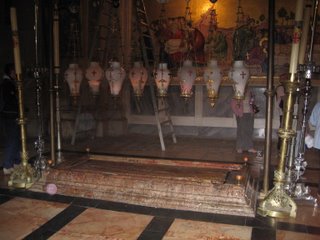Exploring the Old City
It's Sunday night and I'm looking forward to another week at the Center. This weekend, I had the opportunity to do some exploring around the Old City.
Jerusalem's Old City has the highest concentration of holy sites in the world, all packed into an area less than 1 square km.
After walking down Yaffa (or Jaffa) street I entered the Old City through the Jaffa Gate and walked through the Armenian Quarter, and into the Christian and Jewish Quarters.

This is a typical street in the Old City, next to the restored main street from the Roman times, called the Cardo.

In 1967, the entire Old City of Jerusalem was captured by Israel, ending the division that had been in place ince 1948. It once again became possible for Jews to visit the holy site of the Western Wall. The reunification of the Old City also spawned a massive restoration effort of the Jewish Quarter (see the inscription on the bottom left tile).

Another street in the Old City, with people walking home from visiting the Western Wall (or Kotel, in Hebrew).
 I was wandering through the Christian Quarter, when I happened upon this: the entrance to the Church of the Holy Sepulchre. This is one of the holiest sites in Christianity and is jointly administered by several different Christian sects who share responsibilities in a relatively tense arrangement that has been known to erupt in fist fights. The responsibilities of the various monks are minutely laid out in a charter that was established in the 19th century. In a humourous oversight, none of the orders was assigned responibility for the exterior of the building, so when a wooden ladder was placed on the window sill above the entrance in the 1850's, none of the monks wanted to cause an incident by removing it. If you look at the picture I took this weekend, you can see that this "Immovable ladder" is still there.
I was wandering through the Christian Quarter, when I happened upon this: the entrance to the Church of the Holy Sepulchre. This is one of the holiest sites in Christianity and is jointly administered by several different Christian sects who share responsibilities in a relatively tense arrangement that has been known to erupt in fist fights. The responsibilities of the various monks are minutely laid out in a charter that was established in the 19th century. In a humourous oversight, none of the orders was assigned responibility for the exterior of the building, so when a wooden ladder was placed on the window sill above the entrance in the 1850's, none of the monks wanted to cause an incident by removing it. If you look at the picture I took this weekend, you can see that this "Immovable ladder" is still there.
I found this picture of the ladder dating from 1892 on Wikipedia (www.wikipedia.org).

The pink-hued stone seen here is called "The Stone of Unction," and is purported to be the stone where Jesus' body was prepared for burial after being taken down from the cross. Pilgrims from around the world come here to touch and kiss the stone.
The Church is also supposed to contain the tomb (or sepulchre) of Jesus. Of course, some people argue the authenticity of the artifacts here, but from my perspective, the "authenticity" of these objects has little to do with their actual importance. Whether or not they are real, people have been coming to see these artifacts and to feel closer to their faith for over a thousand years.
That's all for now. Stay tuned for more updates - I'll definitely write a little on the election happening here on Tuesday.
Cheers,
Seth

0 Comments:
Post a Comment
<< Home